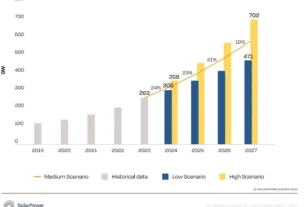According to forecasts by the International Energy Agency (IEA), global electricity demand is expected to grow at a robust pace of 3.3% in 2025 and 3.7% in 2026, significantly outpacing total energy demand growth.
🔋 Renewable Energy on Track to Lead
- Solar, wind, and other renewable sources are projected to overtake coal as the world’s largest source of electricity by 2025 or 2026 at the latest. This shift depends on trends in fuel pricing and weather patterns.
- Nuclear power is also forecast to hit record output levels, while natural gas continues to displace coal and oil in many regions.
🌏 Demand Growth by Region
- Evidence suggests that China and India will account for around 60% of global electricity demand growth through 2026, with India’s growth accelerating from 4% to 6.6% year-over-year.
- In the United States, demand is expected to remain above 2% annually, driven by growth in data centers and electrification.
- The European Union is expected to grow more moderately, at around 1% per year through 2025 and 2026.
📉 Trend Impact on Emissions
While demand rises, electricity sector CO₂ emissions are forecast to flatten in 2025 and decline slightly in 2026. This stabilization comes amid aggressive growth in renewables, nuclear, and gas generation—reducing reliance on coal.
🧭 Summary Table
Factor | Details |
Electricity Demand Growth | 3.3% (2025), 3.7% (2026) > overall energy demand growth |
Renewables vs. Coal | Renewables likely to overtake coal by 2025–2026 |
Other Energy Trends | Nuclear and gas expanding; solar + wind driving demand coverage |
Regional Highlights | China & India = 60% of growth; US demand >2%; EU ~1% growth |
Emissions Outlook | CO₂ emissions plateauing in 2025 and slightly declining in 2026 |
✅ Bottom Line
As global power demand accelerates, renewable energy—especially solar and wind—is ascending rapidly and is projected to replace coal as the leading electricity source by 2025 or 2026. This transition, supported by expanding nuclear output and gas-fired generation, is expected to slow emissions growth, even as electricity needs continue rising around the world.




